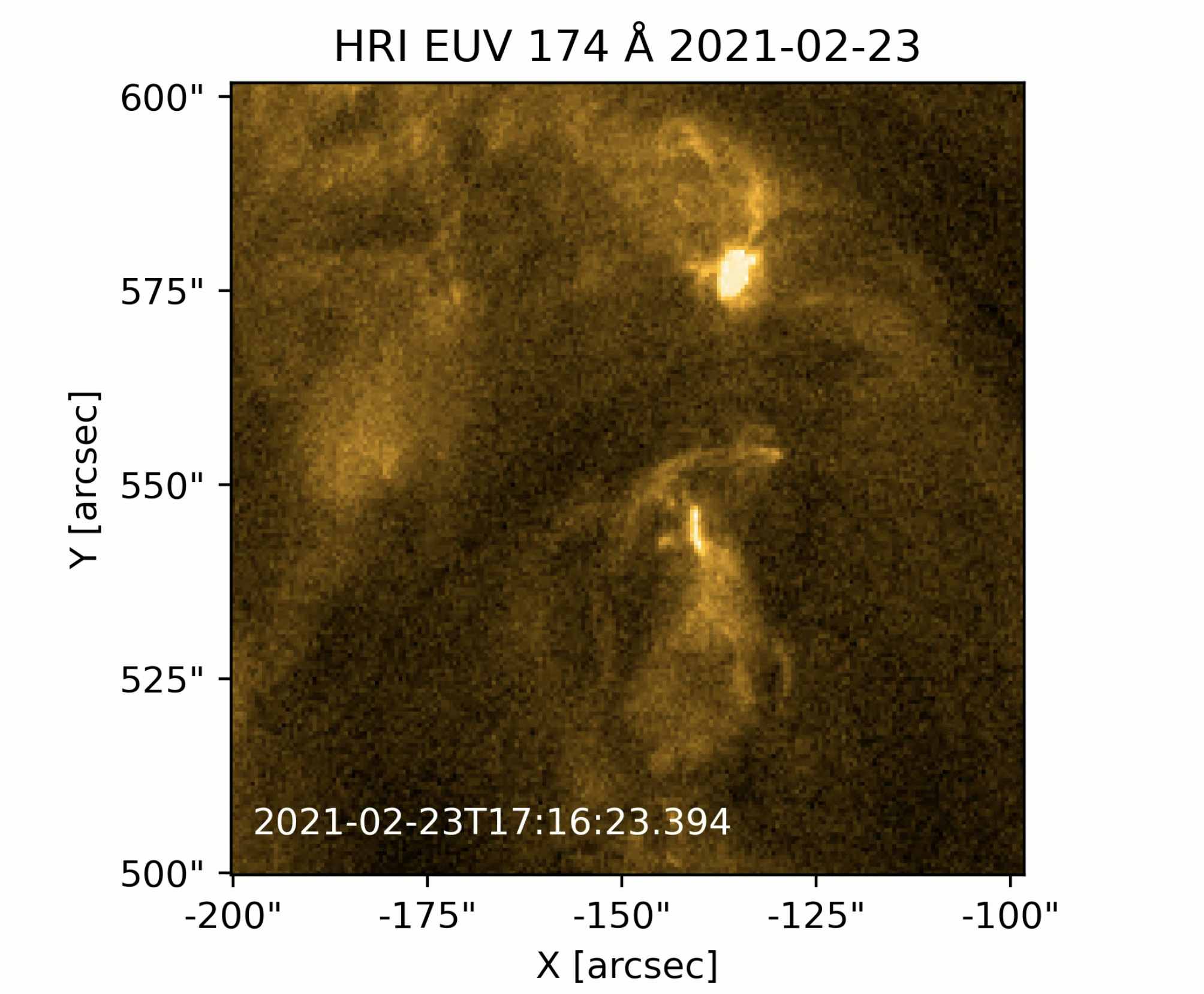The Extreme Ultraviolet Imager (EUI) telescope aboard the satellite Solar Orbiter was able to observe magnetic loops that shake back and forth very quickly. These vibrations are very small, but are ubiquitous and ever-present. Scientists suspect that it is these movements that heat the environment around the sun to millions of degrees Celsius. By comparison, the solar surface is only a few thousand degrees in temperature.
Loop oscillations observed by the EUI telescope on 23 February 2021. Click on the image to view the movie.
De lussen die zeer snel in kleine bewegingen heen en weer schudden werden waargenomen door de EUI telescoop op 23 februari 2021. Klik op de afbeelding voor een film.
Les boucles qui s'agitent très rapidement en petits mouvements ont été observées par le télescope EUI le 23 février 2021. Cliquez sur l'image pour voir un film.
The sun is dotted with magnetic loops. Now it was discovered that these loops oscillate back and forth continuously and very quickly. Some of the energy from the oscillations dissipates into the solar atmosphere, heating it. This may well explain the mystery of the solar atmosphere being much hotter than the solar surface. You would expect these vibrations to stop after a while, but as it turns out, the loops are driven continuously. Scientists suspect that the swirling solar material, from which the loops emerge, causes them to vibrate. This needs further investigation.
This discovery was only possible thanks to the EUI telescope which can take extremely sharp images in rapid succession. Other comparable solar telescopes cannot: either they are slower or the images are less sharp.
The Astrophysical Journal publishes the scientific paper in which researchers from the Solar-Terrestrial Centre of Excellence and the Katholieke Universiteit Leuven describe this new discovery.
More information here.
Nieuw soort trillingen ontdekt op de zon
De telescoop Extreme Ultraviolet Imager (EUI) aan boord van de satelliet Solar Orbiter kon magnetische lussen filmen die zeer snel heen en weer schudden. Deze trillingen zijn zeer klein, maar zijn alom en altijd aanwezig. Wetenschappers vermoeden dat het deze bewegingen zijn die de omgeving rond de zon tot miljoenen graden celsius verhitten. Ter vergelijking: het zonneoppervlak is slechts enkele duizenden graden warm.
De zon is bezaaid met magnetische lussen. Nu blijkt dat deze lussen continu en zeer snel heen en weer schommelen. Een deel van de energie van de trillingen wordt afgestaan aan de omgeving waardoor deze opwarmt. Dit zou wel eens een verklaring kunnen zijn voor het mysterie van de zonneatmosfeer die zoveel heter is dan het zonneoppervlak. Je zou verwachten dat deze trillingen na een tijd stil vallen, maar niets is minder waar. De lussen worden continu aangedreven. Wetenschappers vermoeden dat de kolkende zonnemassa, waaruit de lussen tevoorschijn komen, hen doet trillen. Dit moet nog verder onderzocht worden.
Deze ontdekking was maar mogelijk dankzij de telescoop EUI die uiterst scherpe beelden heel snel achter elkaar kan maken. Andere vergelijkbare zonnetelescopen kunnen dit niet: ofwel zijn ze trager ofwel zijn de beelden minder scherp.
Het wetenschappelijke artikel over deze ontdekking werd gepubliceerd in het Astrophysical Journal. Onderzoekers van het Solar-Terrestrial Centre of Excellence en de Katholieke Universiteit Leuven werkten hieraan mee.
Meer info hier (En).
Découverte d'un nouveau type de vibrations magnétiques sur le Soleil
Le télescope EUI (Extreme Ultraviolet Imager) du satellite Solar Orbiter a pu filmer des boucles magnétiques qui s'agitent très rapidement en va-et-vient. Ces vibrations sont très faibles, mais sont présentes partout, en continu. Les scientifiques pensent que c’est au moyen de ces oscillations que l'atmosphère du Soleil est chauffée à des millions de degrés Celsius. En comparaison, la surface du Soleil n’a qu’une température de quelques milliers de degrés Celsius.
Le Soleil est parsemé de boucles magnétiques. Il s'avère que ces boucles oscillent continuellement et très rapidement en va-et-vient. Ces oscillations transmettent une partie de leur énergie à l'environnement du Soleil et le réchauffent. Cela pourrait bien expliquer le mystère de l'atmosphère solaire qui est beaucoup plus chaude que la surface du Soleil. On pourrait s'attendre à ce que ces vibrations s'arrêtent au bout d'un certain temps, mais rien n'est moins vrai. Les boucles oscillent en permanence. Les scientifiques pensent que la masse solaire tourbillonnante, d'où émergent les boucles, les fait vibrer. Cette hypothèse doit faire l'objet d'un examen plus approfondi.
Cette découverte n'a été possible que grâce au télescope EUI qui peut prendre des images extrêmement nettes en succession rapide. D'autres télescopes solaires comparables ne peuvent pas faire cela : soit ils sont plus lents, soit les images sont moins nettes.
L'Astrophysical Journal a publié l'article dans lequel les scientifiques du Solar-Terrestrial Centre of Excellence et de la Katholieke Universiteit Leuven décrivent cette nouvelle découverte.
Plus d'info (En).
EUI Milestones
2020 February 9 - Launch of Solar Orbiter
2020 February 25 - Instrument wake-up
2020 May 12 - First Light - Discovery of campfires !
2022 February 15 - Unique images of a solar cloud
2022 March 7 - First EUI mosaic
2022 March 26 - Close approach to the Sun
2023 January 3 - Mercury transit






